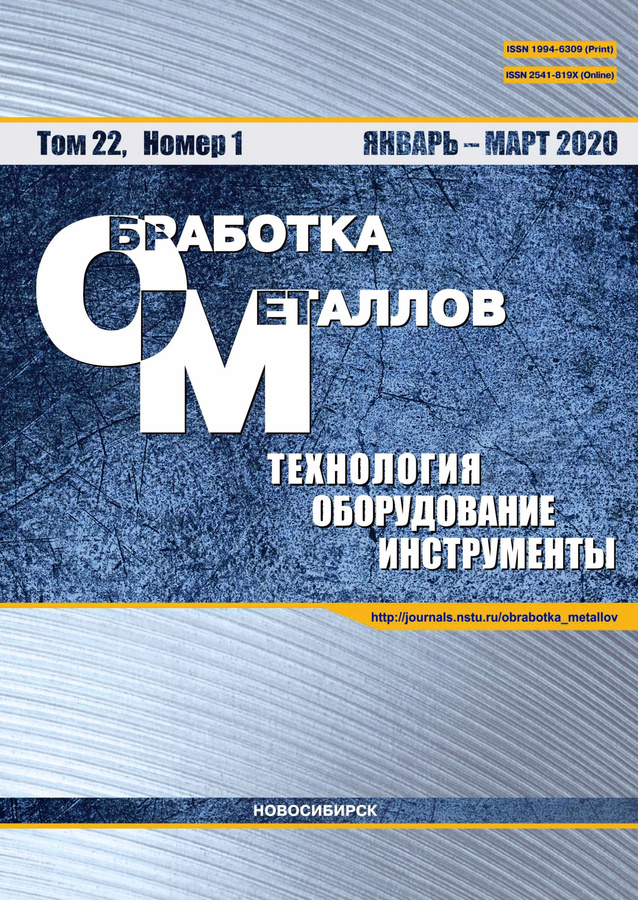The Influence of the Cutting Speed of Metals on the Regeneration of the Vibratory Oscillations of the Tool in Machines of the Turning Group
- Authors: Viktor L.P.1
-
Affiliations:
- Issue: Vol 22, No 1 (2020)
- Pages: 65-79
- Section: EQUIPMENT. INSTRUMENTS
- URL: https://bakhtiniada.ru/1994-6309/article/view/301974
- DOI: https://doi.org/10.17212/1994-6309-2020-22.1-65-79
- ID: 301974
Cite item
Full Text
Abstract
About the authors
L. P. Viktor
Email: Lapshin1917@yandex.ru
Ph.D. (Engineering), Associate Professor, Don State Technical University, 1 Gagarin square, Rostov-on-Don, 344000, Russian Federation, Lapshin1917@yandex.ru
References
- Hahn R.S. On the theory of regenerative chatter in precision grinding operation // Transactions of American Society of Mechanical Engineers. – 1954. – Vol. 76. – P. 356–260.
- Tobias S.A., Fishwick W. Theory of regenerative machine tool chatter // The Engineer. – 1958. – Vol. 205, N 7. – P. 199–203.
- Merritt H.E. Theory of self-excited machine-tool chatter: contribution to machine-tool chatter research – 1 // Journal of Engineering for Industry. – 1965. – Vol. 87, N 4. – P. 447–454. – doi: 10.1115/1.3670861.
- Hanna N.H., Tobias S.A. A theory of nonlinear regenerative chatter // Journal of Engineering for Industry. – 1974. – Vol. 96, N 1. – P. 247–255.
- Tlusty I., Ismail F. Basic non-linearity in machining chatter // CIRP Annals. – 1981. – Vol. 30. – P. 299–304. – doi: 10.1016/S0007-8506(07)60946-9.
- Altintas Y., Budak E. Analytical prediction of stability lobes in milling // CIRP Annals. – 1995. – Vol. 44, N 1. – P. 357–362. – doi: 10.1016/S0007-8506(07)62342-7.
- Insperger T., Stépán G. Stability of the milling process // Periodica Polytechnica Mechanical Engineering. – 2000. – Vol. 44, N 1. – P. 47–57.
- Wiercigroch M., Budak E. Sources of nonlinearities, chatter generation and suppression in metal cutting // Philosophical Transactions of the Royal Society A: Mathematical, Physical and Engineering Sciences. – 2001. – N 359. – P. 663–693. – doi: 10.1098/rsta.2000.0750.
- Grabec I. Chaos generated by the cutting process // Physics Letters A. – 1986. – Vol. 117, N 8. – P. 384–386. – doi: 10.1016/0375-9601(86)90003-4.
- Balachandran B. Nonlinear dynamics of milling process // Philosophical Transactions of the Royal Society A: Mathematical, Physical and Engineering Sciences. – 2001. – Vol. 359. – P. 793–819.
- Stepan G. Modelling nonlinear regenerative e?ects in metal cutting // Philosophical Transactions of the Royal Society A: Mathematical, Physical and Engineering Sciences. – 2001. – Vol. 359. – P. 739–757. – doi: 10.1098/rsta.2000.07537.
- Litak G. Chaotic vibrations in a regenerative cutting process // Chaos Solitons and Fractals. – 2002. – Vol. 13. – P. 1531–1535. – doi: 10.1016/S0960-0779(01)00176-X.
- Namachchivaya S., Beddini. Spindle speed variation for the suppression of regenerative chatter // Journal of Nonlinear Science. – 2003. – Vol. 13, N 3. – P. 265–288. – doi: 10.1007/s00332-003-0518-4.
- Wahi P., Chatterjee A. Regenerative tool chatter near a codimension 2 Hopf point using multiple scales // Nonlinear Dynamics. – 2005. – Vol. 40, N 4. – P. 323–338.
- Stépán G., Insperger T., Szalai R. Delay, parametric excitation, and the nonlinear dynamics of cutting processes // International Journal of Bifurcation and Chaos. – 2005. – Vol. 15, N 9. – P. 2783–2798. – doi: 10.1142/S0218127405013642.
- Nonlinear behaviour of the regenerative chatter in turning process with a worn tool: forced oscillation and stability analysis / H. Moradi, F. Bakhtiari-Nejad, M.R. Movahhedy, M.T. Ahmadian // Mechanism and Machine Theory. – 2010. – Vol. 45, N 8. – P. 1050–1066. – doi: 10.1016/j.mechmachtheory.2010.03.014.
- Nonlinear dynamics of a machining system with two interdependent delays / A.M. Gouskov, S.A. Voronov, H. Paris, S.A. Batzer // Communications in Nonlinear Science and Numerical Simulation. – 2002. – Vol. 7, N 4. – P. 207–221. – doi: 10.1016/S1007-5704(02)00014-X.
- Гуськов А.М., Воронов С.А., Квашнин А.С. Влияние крутильных колебаний на процесс вибросверления // Вестник МГТУ им. Н.Э. Баумана. Серия: Машиностроение. – 2007. – № 1 (66). – С. 3–19.
- Васин С.А., Васин Л.А. Синергетический подход к описанию природы возникновения и развития автоколебаний при точении // Наукоемкие технологии в машиностроении. – 2012. – № 1. – С. 11–16.
- Воронин А.А. Влияние ультразвуковых колебаний на процесс резания жаропрочных сплавов // Станки и инструмент. – 1960. – № 11. – С. 15–18.
- Заковоротный В.Л., Лапшин В.П., Губанова А.А. Определение оптимальных траекторий при обработке с учетом эволюции процесса резания // Вестник Донского государственного технического университета. – 2014. – Т. 14, № 3 (78). – doi: 10.12737/5715.
- Zakovorotny V.L., Lapshin V.P., Babenko T.S. Assessing the regenerative effect impact on the dynamics of deformation movements of the tool during turning // Procedia Engineering. – 2017. – Vol. 206. – P. 68–73. – doi: 10.1016/j.proeng.2017.10.439.
- Bifurcation of stationary manifolds formed in the neighborhood of the equilibrium in a dynamic system of cutting / V.L. Zakovorotny, A.D. Lukyanov, A.A. Gubanova, V.V. Khristoforova // Journal of Sound and Vibration. – 2016. – Vol. 368. – P. 174–190. – DOI: 10.1016/j. jsv.2016.01.020.
- Lapshin V.P., Turkin I.A. Dynamic influence of the spindle servo drive on the drilling of deep narrow holes // Russian Engineering Research. – 2015. – Vol. 35, N 10. – P. 795–797. – doi: 10.3103/S1068798X15100111.
- Рыжкин А.А., Шучев К.Г., Климов М.М. Обработка материалов резанием. – Ростов н/Д.: Феникс, 2008. – 418 с. – ISBN 978-5-7890-0413-X.
- Вульф А.М. Резание металлов. – Л.: Машиностроение, 1973. – 496 с.
- Зорев Н.Н. Вопросы механики процесса резания металлов. – М.: Машгиз, 1956. – 367 с.
- Макаров А.Д. Оптимизация процессов резания. – М.: Машиностроение, 1976. – 278 с.
- Попов Е.П., Пальтов И.П. Приближенные методы исследования нелинейных автоматических систем. – M.: Физматгиз, 1960. – 792 с.
Supplementary files






